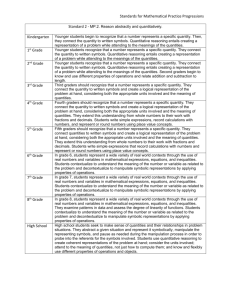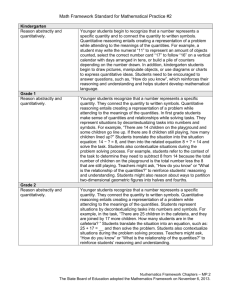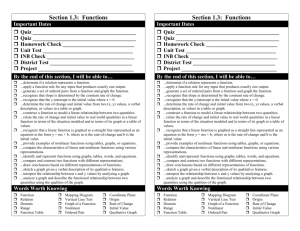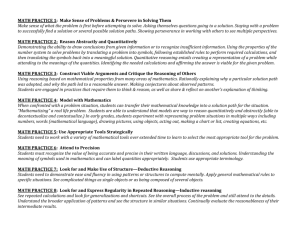SMP #2 Reason Abstractly
advertisement
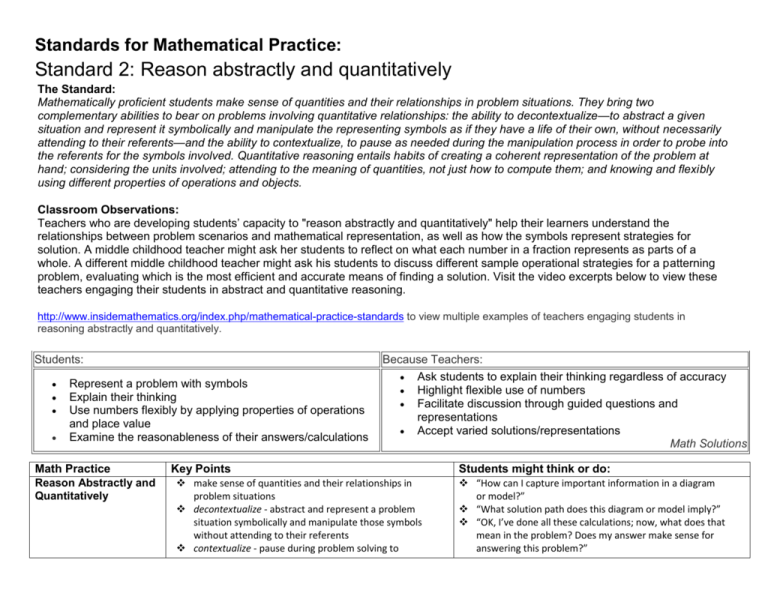
Standards for Mathematical Practice: Standard 2: Reason abstractly and quantitatively The Standard: Mathematically proficient students make sense of quantities and their relationships in problem situations. They bring two complementary abilities to bear on problems involving quantitative relationships: the ability to decontextualize—to abstract a given situation and represent it symbolically and manipulate the representing symbols as if they have a life of their own, without necessarily attending to their referents—and the ability to contextualize, to pause as needed during the manipulation process in order to probe into the referents for the symbols involved. Quantitative reasoning entails habits of creating a coherent representation of the problem at hand; considering the units involved; attending to the meaning of quantities, not just how to compute them; and knowing and flexibly using different properties of operations and objects. Classroom Observations: Teachers who are developing students’ capacity to "reason abstractly and quantitatively" help their learners understand the relationships between problem scenarios and mathematical representation, as well as how the symbols represent strategies for solution. A middle childhood teacher might ask her students to reflect on what each number in a fraction represents as parts of a whole. A different middle childhood teacher might ask his students to discuss different sample operational strategies for a patterning problem, evaluating which is the most efficient and accurate means of finding a solution. Visit the video excerpts below to view these teachers engaging their students in abstract and quantitative reasoning. http://www.insidemathematics.org/index.php/mathematical-practice-standards to view multiple examples of teachers engaging students in reasoning abstractly and quantitatively. Students: Represent a problem with symbols Explain their thinking Use numbers flexibly by applying properties of operations and place value Examine the reasonableness of their answers/calculations Math Practice Reason Abstractly and Quantitatively Because Teachers: Ask students to explain their thinking regardless of accuracy Highlight flexible use of numbers Facilitate discussion through guided questions and representations Accept varied solutions/representations Math Solutions Key Points make sense of quantities and their relationships in problem situations decontextualize - abstract and represent a problem situation symbolically and manipulate those symbols without attending to their referents contextualize - pause during problem solving to Students might think or do: “How can I capture important information in a diagram or model?” “What solution path does this diagram or model imply?” “OK, I’ve done all these calculations; now, what does that mean in the problem? Does my answer make sense for answering this problem?” connect symbolic work back to the context of the problem Given the problem: There are 3/5 as many boys as girls. If Pay attention to the important quantities and relationships there are 45 boys, how many girls are there?, a student between them can create a diagram that shows the relationship between use representations to highlight those relationships and the number. the underlying mathematical structure of a problem Education Development Center, Inc. Reason Abstractly and Quantitatively Questions to Develop Mathematical Thinking Make sense of quantities and their relationships. What do the numbers used in the problem represent? Are able to decontextualize (represent a situation symbolically What is the relationship of the quantities? and manipulate the symbols) and contextualize (make How is ___ related to ___? meaning of the symbols in a problem) quantitative What properties might we use to find a solution? relationships. What does ___ mean to you? (e.g., symbol, quantity, diagram) Understand the meaning of quantities and are flexible in the How did you decide in this task that you needed to use . . . ? use of operations and their properties. Could we have used another operation or property to solve this task? Create a logical representation of the problem. Why or why not? Attends to the meaning of quantities, not just how to compute them. CCSS-M Flip Books: http://katm.org/wp/common-core/ Practice Reason Abstractly and Quantitativ ely Needs Improvement Task: Lacks context. Does not make use of multiple representations or solution paths. Teacher: Does not expect students to interpret representations. Expects students to memorize procedures with no connection to meaning. Emerging (teacher does thinking) Task: Is embedded in a contrived context. Teacher: Expects students to model and interpret tasks using a single representation. Explains connections between procedures and meaning. Proficient (teacher mostly models) Task: Has realistic context. Requires students to frame solutions in a context. Has solutions that can be expressed with multiple representations. Teacher: Expects students to interpret and model using multiple representations. Provides structure for students to connect algebraic procedures to contextual meaning. Links mathematical solution with a question’s answer. Exemplary (students take ownership) Task: Has relevant realistic context. Teacher: Expects students to interpret, model, and connect multiple representations. Prompts students to articulate connections between algebraic procedures and contextual meaning. Institute for Advanced Study Park City Mathematics Institute
